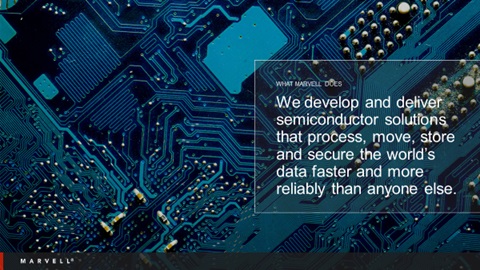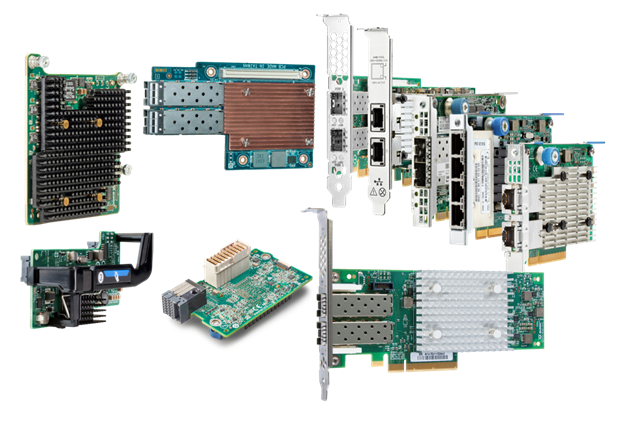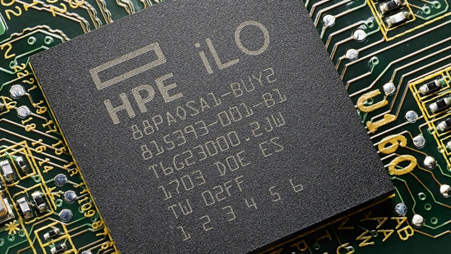Archive for the 'Server Connectivity' Category
-
January 25, 2024
How PCIe Interconnect is Critical for the Emerging AI Era
By Annie Liao, Product Management Director, Connectivity, Marvell
PCIe has historically been used as protocol for communication between CPU and computer subsystems. It has gradually increased speed since its debut in 2003 (PCI Express) and after 20 years of PCIe development, we are currently at PCIe Gen 5 with I/O bandwidth of 32Gbps per lane. There are many factors driving the PCIe speed increase. The most prominent ones are artificial intelligence (AI) and machine learning (ML). In order for CPU and AI Accelerators/GPUs to effectively work with each other for larger training models, the communication bandwidth of the PCIe-based interconnects between them needs to scale to keep up with the exponentially increasing size of parameters and data sets used in AI models. As the number of PCIe lanes supported increases with each generation, the physical constraints of the package beachfront and PCB routing put a limit to the maximum number of lanes in a system. This leaves I/O speed increase as the only way to push more data transactions per second. The compute interconnect bandwidth demand fueled by AI and ML is driving a faster transition to the next generation of PCIe, which is PCIe Gen 6.
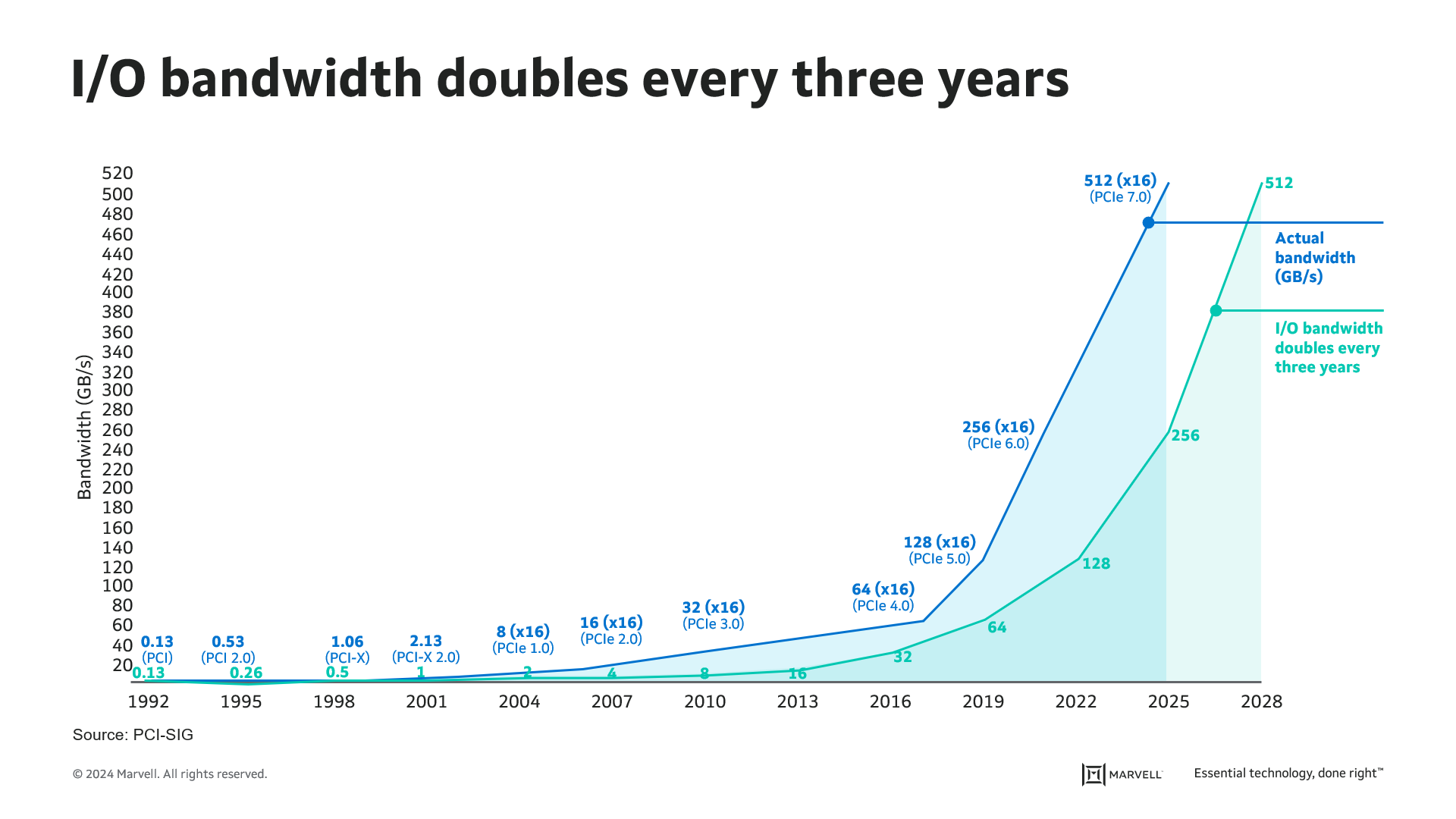
PCIe has been using 2-level Non-Return-to-Zero (NRZ) modulation since its inception. Increasing PCIe speed up to Gen 5 has been achieved through doubling of the I/O speed. For Gen 6, PCI-SIG decided to adopt Pulse-Amplitude Modulation 4 (PAM4), which carries 4-level signal encoding 2 bits of data (00, 01, 10, 11). The reduced margin resulting from the transition of 2-level signaling to 4-level signaling has also necessitated the use of Forward Error Correction (FEC) protection, a first for PCIe links. With the adoptions of PAM4 signaling and FEC, Gen 6 marks an inflection point for PCIe both from signaling and protocol layer perspectives.
In addition to AI/ML, disaggregation of memory and storage is an emerging trend in compute applications that has a significant impact in the applications of PCIe based interconnect. PCIe has historically been adopted on-board and for in-chassis interconnects. Attaching more front-facing NVMe SSDs is one of the common PCIe interconnect examples. With the increasing trends toward flexible resource allocation, and the advancement of CXL technology, the server industry is now moving toward disaggregated and composable infrastructure. In this disaggregated architecture, the PCIe end points are located at different chassis away from the PCIe root complex, requiring the PCIe link to travel out of the system chassis. This is typically achieved through direct attach cables (DAC) that can range up to 3-5m.
-
October 19, 2023
Shining a Light on Marvell Optical Technology and Innovation in the AI Era
By Kristin Hehir, Senior Manager, PR and Marketing, Marvell
The sheer volume of data traffic moving across networks daily is mind-boggling almost any way you look at it. During the past decade, global internet traffic grew by approximately 20x, according to the International Energy Agency. One contributing factor to this growth is the popularity of mobile devices and applications: Smartphone users spend an average of 5 hours a day, or nearly 1/3 of their time awake, on their devices, up from three hours just a few years ago. The result is incredible amounts of data in the cloud that need to be processed and moved. Around 70% of data traffic is east-west traffic, or the data traffic inside data centers. Generative AI, and the exponential growth in the size of data sets needed to feed AI, will invariably continue to push the curb upward.
Yet, for more than a decade, total power consumption has stayed relatively flat thanks to innovations in storage, processing, networking and optical technology for data infrastructure. The debut of PAM4 digital signal processors (DSPs) for accelerating traffic inside data centers and coherent DSPs for pluggable modules have played a large, but often quiet, role in paving the way for growth while reducing cost and power per bit.
Marvell at ECOC 2023
At Marvell, we’ve been gratified to see these technologies get more attention. At the recent European Conference on Optical Communication, Dr. Loi Nguyen, EVP and GM of Optical at Marvell, talked with Lightwave editor in chief, Sean Buckley, on how Marvell 800 Gbps and 1.6 Tbps technologies will enable AI to scale.
-
June 27, 2023
Scaling AI Infrastructure with High-Speed Optical Connectivity
By Suhas Nayak, Senior Director of Solutions Marketing, Marvell

In the world of artificial intelligence (AI), where compute performance often steals the spotlight, there's an unsung hero working tirelessly behind the scenes. It's something that connects the dots and propels AI platforms to new frontiers. Welcome to the realm of optical connectivity, where data transfer becomes lightning-fast and AI's true potential is unleashed. But wait, before you dismiss the idea of optical connectivity as just another technical detail, let's pause and reflect. Think about it: every breakthrough in AI, every mind-bending innovation, is built on the shoulders of data—massive amounts of it. And to keep up with the insatiable appetite of AI workloads, we need more than just raw compute power. We need a seamless, high-speed highway that allows data to flow freely, powering AI platforms to conquer new challenges.
In this post, I’ll explain the importance of optical connectivity, particularly the role of DSP-based optical connectivity, in driving scalable AI platforms in the cloud. So, buckle up, get ready to embark on a journey where we unlock the true power of AI together.
-
June 13, 2023
FC-NVMe Goes Mainstream for Next-Generation Block Storage from HPE
By Todd Owens, Field Marketing Director, Marvell
While Fibre Channel (FC) has been around for a couple of decades now, the Fibre Channel industry continues to develop the technology in ways that keep it in the forefront of the data center for shared storage connectivity. Always a reliable technology, continued innovations in performance, security and manageability have made Fibre Channel I/O the go-to connectivity option for business-critical applications that leverage the most advanced shared storage arrays.
A recent development that highlights the progress and significance of Fibre Channel is Hewlett Packard Enterprise’s (HPE) recent announcement of their latest offering in their Storage as a Service (SaaS) lineup with 32Gb Fibre Channel connectivity. HPE GreenLake for Block Storage MP powered by HPE Alletra Storage MP hardware features a next-generation platform connected to the storage area network (SAN) using either traditional SCSI-based FC or NVMe over FC connectivity. This innovative solution not only provides customers with highly scalable capabilities but also delivers cloud-like management, allowing HPE customers to consume block storage any way they desire – own and manage, outsource management, or consume on demand.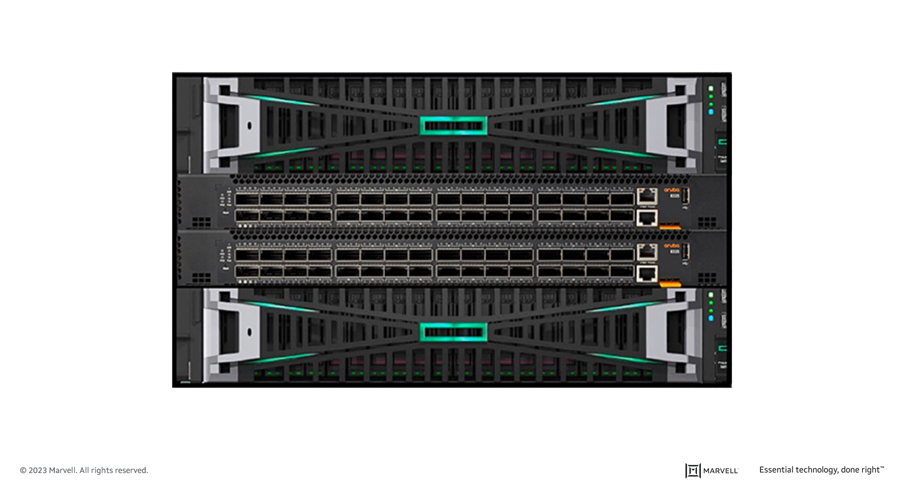 HPE GreenLake for Block Storage powered by Alletra Storage MP
HPE GreenLake for Block Storage powered by Alletra Storage MPAt launch, HPE is providing FC connectivity for this storage system to the host servers and supporting both FC-SCSI and native FC-NVMe. HPE plans to provide additional connectivity options in the future, but the fact they prioritized FC connectivity speaks volumes of the customer demand for mature, reliable, and low latency FC technology.
-
June 12, 2023
AI and the Tectonic Shift Coming to Data Infrastructure
By Michael Kanellos, Head of Influencer Relations, Marvell
AI’s growth is unprecedented from any angle you look at it. The size of large training models is growing 10x per year. ChatGPT’s 173 million plus users are turning to the website an estimated 60 million times a day (compared to zero the year before.). And daily, people are coming up with new applications and use cases.
As a result, cloud service providers and others will have to transform their infrastructures in similarly dramatic ways to keep up, says Chris Koopmans, Chief Operations Officer at Marvell in conversation with Futurum’s Daniel Newman during the Six Five Summit on June 8, 2023.
“We are at the beginning of at least a decade-long trend and a tectonic shift in how data centers are architected and how data centers are built,” he said.
The transformation is already underway. AI training, and a growing percentage of cloud-based inference, has already shifted from running on two-socket servers based around general processors to systems containing eight more GPUs or TPUs optimized to solve a smaller set of problems more quickly and efficiently.
-
December 05, 2022
Leading Lights Award Recognizes Deneb CDSP Leadership
By Johnny Truong, Senior Manager, Public Relations, Marvell
 At this weeks’ Leading Lights Awards Ceremony, hosted by Light Reading, Editor-in-Chief Phil Harvey announced that the Marvell® Deneb™ Coherent Digital Signal Processor (CDSP) is the winner of the Most Innovative Service Provider Transport Solution category. This recognition is awarded to the optical systems vendor or optical components vendor providing the most innovative optical transport solution for service provider customers.
At this weeks’ Leading Lights Awards Ceremony, hosted by Light Reading, Editor-in-Chief Phil Harvey announced that the Marvell® Deneb™ Coherent Digital Signal Processor (CDSP) is the winner of the Most Innovative Service Provider Transport Solution category. This recognition is awarded to the optical systems vendor or optical components vendor providing the most innovative optical transport solution for service provider customers.Driving the industry's largest standards-based ecosystem, the Marvell Deneb CDSP enables disaggregation which is critical for carriers to lower their CAPEX and OPEX as they increase network capacity. This recognition underscores Marvell’s success in bringing leading-edge density and performance optimization advantages to carrier networks.
In its 18th year, the Leading Lights is Light Reading’s flagship awards program which recognizes top companies and executives for their outstanding achievements in next-generation communications technology, applications, services, strategies, and innovations.
Visit the Light Reading blog for a full list of categories, finalists and winners.
-
August 19, 2020
Navigating Product Name Changes for Marvell Ethernet Adapters at HPE
By Todd Owens, Field Marketing Director, Marvell

Hewlett Packard Enterprise (HPE) recently updated its product naming protocol for the Ethernet adapters in its HPE ProLiant and HPE Apollo servers. Its new approach is to include the ASIC model vendor’s name in the HPE adapter’s product name. This commonsense approach eliminates the need for model number decoder rings on the part of Channel Partners and the HPE Field team and provides everyone with more visibility and clarity. This change also aligns more with the approach HPE has been taking with their “Open” adapters on HPE ProLiant Gen10 Plus servers. All of this is good news for everyone in the server sales ecosystem, including the end user. The products’ core SKU numbers remain the same, too, which is also good.
-
July 28, 2020
Living on the Network Edge: Security
By Alik Fishman, Director of Product Management, Marvell

In our series Living on the Network Edge, we have looked at the trends driving Intelligence, Performance and Telemetry to the network edge. In this installment, let’s look at the changing role of network security and the ways integrating security capabilities in network access can assist in effectively streamlining policy enforcement, protection, and remediation across the infrastructure.
Cybersecurity threats are now a daily struggle for businesses experiencing a huge increase in hacked and breached data from sources increasingly common in the workplace like mobile and IoT devices. Not only are the number of security breaches going up, they are also increasing in severity and duration, with the average lifecycle from breach to containment lasting nearly a year1 and presenting expensive operational challenges. With the digital transformation and emerging technology landscape (remote access, cloud-native models, proliferation of IoT devices, etc.) dramatically impacting networking architectures and operations, new security risks are introduced. To address this, enterprise infrastructure is on the verge of a remarkable change, elevating network intelligence, performance, visibility and security2.
-
July 23, 2020
Telemetry: Can You See the Edge?
By Suresh Ravindran, Senior Director, Software Engineering

So far in our series Living on the Network Edge, we have looked at trends driving Intelligence and Performance to the network edge. In this blog, let’s look into the need for visibility into the network.
As automation trends evolve, the number of connected devices is seeing explosive growth. IDC estimates that there will be 41.6 billion connected IoT devices generating a whopping 79.4 zettabytes of data in 20251. A significant portion of this traffic will be video flows and sensor traffic which will need to be intelligently processed for applications such as personalized user services, inventory management, intrusion prevention and load balancing across a hybrid cloud model. Networking devices will need to be equipped with the ability to intelligently manage processing resources to efficiently handle huge amounts of data flows.
-
July 16, 2020
The Need for Speed at the Edge
By George Hervey, Principal Architect, Marvell

In the previous TIPS to Living on the Edge, we looked at the trend of driving network intelligence to the edge. With the capacity enabled by the latest wireless networks, like 5G, the infrastructure will enable the development of innovative applications. These applications often employ a high-frequency activity model, for example video or sensors, where the activities are often initiated by the devices themselves generating massive amounts of data moving across the network infrastructure. Cisco’s VNI Forecast Highlights predicts that global business mobile data traffic will grow six-fold from 2017 to 2022, or at an annual growth rate of 42 percent1, requiring a performance upgrade of the network.
-
July 08, 2020
Driving Network Intelligence and Processing to the Edge
By George Hervey, Principal Architect, Marvell

The mobile phone has become such an essential part of our lives as we move towards more advanced stages of the “always on, always connected” model. Our phones provide instant access to data and communication mediums, and that access influences the decisions we make and ultimately, our behavior.
According to Cisco, global mobile networks will support more than 12 billion mobile devices and IoT connections by 2022.1 And these mobile devices will support a variety of functions. Already, our phones replace gadgets and enable services. Why carry around a wallet when your phone can provide Apple Pay, Google Pay or make an electronic payment? Who needs to carry car keys when your phone can unlock and start your car or open your garage door? Applications now also include live streaming services that enable VR/AR experiences and sharing in real time. While future services and applications seem unlimited to the imagination, they require next-generation data infrastructure to support and facilitate them. -
September 16, 2019
Marvell’s Advanced Wireless Technology Among First to be Wi-Fi CERTIFIED 6™
By Prabhu Loganathan, Senior Director of Marketing for Connectivity Business Unit, Marvell
Wi-Fi Alliance® the industry alliance responsible for driving certification efforts worldwide to ensure interoperability and standards for Wi-Fi® devices, today announced Wi-Fi CERTIFIED 6™, the industry certification program based on the IEEE 802.11ax standard. Marvell’s 88W9064 (4x4) and 88W9068 (8x8) Wi-Fi 6 solutions are among the first to be Wi-Fi 6 certified and have been selected to be included in the Wi-Fi Alliance interoperability test bed.
Wi-Fi CERTIFIED 6™ ensures interoperability and an improved user experience across all devices running IEEE 802.11ax technology. Wi-Fi 6 benefits both the 5 and 2.4 GHz bands, incorporating major fundamental enhancements like Multi-User MIMO, OFDMA, 1024-QAM, BSS coloring and Target Wait Time.
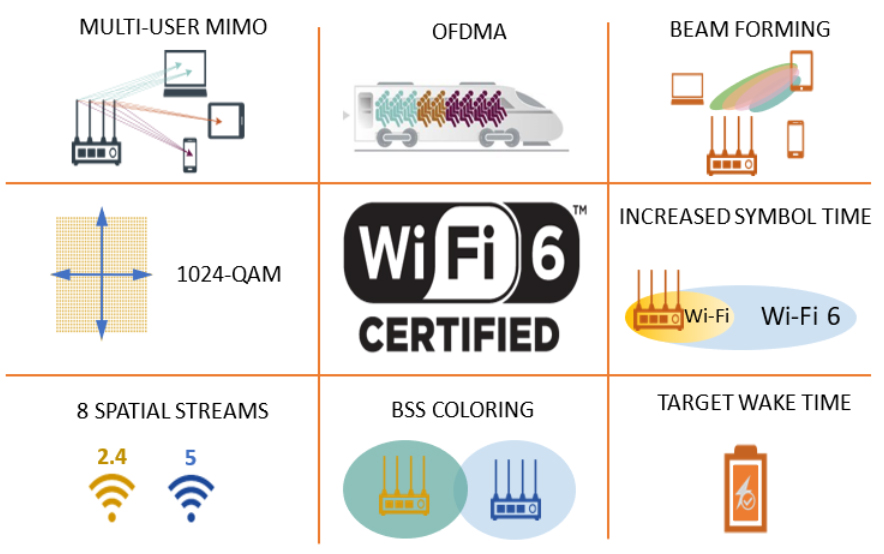 Wi-Fi 6 delivers faster speeds with low latency, high network utilization, and power saving technologies that provide substantial benefits spanning all the way from high density enterprises to enabling battery operated low power IoT devices.
Wi-Fi 6 delivers faster speeds with low latency, high network utilization, and power saving technologies that provide substantial benefits spanning all the way from high density enterprises to enabling battery operated low power IoT devices. Marvell played a leading role in shaping Wi-Fi 6 and enabling Wi-Fi CERTIFIED 6 to ensure seamless interoperability and drive rapid adoption in the market place. Wi-Fi Alliance forecasts that over 1.6 billion devices supporting Wi-Fi 6 will be shipped worldwide by 2020. Marvell is at the forefront of this wave enabling our Wi-Fi CERTIFIED 6 products to be designed into exciting new products spanning infrastructure access, premium client and automotive markets.
For more information, you can visit www.marvell.com/wireless.
-
November 06, 2018
Enhanced Wireless Microcontroller Enables Affordable Design
By Sree Durbha
Today, we are at the peak of technology product availability with the releases of the new iPhone models, Alexa enabled devices and more. In the coming days, there will be numerous international consumer OEMs preparing new offerings as we approach the holiday selling season. Along with the smartphones, voice assistant enabled smart speakers and deep learning wireless security cameras, many devices and appliances are increasingly geared toward automating the home, the office and the factory. These devices are powered by application microcontroller units (MCUs) with embedded wireless connectivity to help users to remotely control and operate them via phone apps, voice or even through mere presence. This is part of an industry trend of pushing intelligence into everyday things. According to analyst firm Techno Systems Research1, this chipset market grew by more than 60% over the course of the last year and is likely to continue this high rate of growth. The democratization of wireless connectivity intellectual property and the continuing shift of semiconductor design and development to low cost regions is helping give rise to new industry players. In order to help customers differentiate in this highly competitive market, Marvell has announced the 88MW320/322 low-power Wi-Fi microcontroller SoC. This chipset is 100% pin-compatible and software compatible with the existing 88MW300/302 based designs. Although the newly released microcontroller is cost-optimized, there are several key hardware and software enhancements in this chipset. Support for extended industrial temperature operation, from -400 C through to 1050 C has been added. Unlike its predecessor, the 88MW320/322 can be implemented into more challenging application areas - such as LED lighting and industrial automation. No RF specific changes have been made within the silicon, so the minimum and maximum RF performance parameters remain the same as before. However, other fixes made have helped improve typical RF performance as reported by some of our customers when evaluating samples. Since there was no change in form, fit or function, the external RF interface remains the same as well. This enables customers to leverage existing 88MW300/302 module and device level regulatory certification on 88MW320/322. A hardware security feature has also been incorporated that allows customers to uniquely tie the chipset to the firmware running on it. This helps prevent counterfeit software to run on the chipset. This chipset is supported by the industry-leading Marvell EZ-Connect SDK for Apple’s new Advanced Development Kit (ADK) and Release 13 HomeKit Accessory Protocol SDK (R13 HAPSDK) with software-based authentication (SoftAuth), Amazon’s AWS IoT and other third-party cloud platforms. The Apple SoftAuth support now allows customers to avoid the cost and hassle of adding the MFi authentication chip, which was previously required to get HomeKit certification. On the applications side, we have added support for the Alexa Voice Services library. With MP3 decoder and OAUTH2 modules integrated on our SDK, our solution now allows customers to add an external audio-codec chipset to offer native voice command translation for basic product control functions. As previously announced, we continue to partner with Dialog Semiconductor to offer support for BLE with shared antenna managed coexistence software with our Wi-Fi on 88MW320/322. Several of our module vendor partners have announced support for this chipset in standalone and Wi-Fi + BLE combo configurations. You can find a complete list of modules supporting this chipset on the Marvell Wireless Microcontrollers page. The 88MW320/322 has been sampling to customers for a few months now and is currently shipping. The product comes in 68-pin QFN package (88MW320) and 88-pin QFN package (88MW322) formats. It is available in commercial, extended, industrial and extended industrial temperature ranges in both tray and tape and reel configurations. Watch this space for future announcements as we extend the availability of Marvell’s solutions for the smart home, office and factory to our customers through our catalog partners. The goal is to enable our wireless microcontroller solutions with easy to install one-click software that allows smaller customers to use our partner reference designs to develop their form factor proof of concept designs with hardware, firmware, middleware, cloud connectivity software, collateral and application support from a single source. This will free up their resources so that they can focus on what is most important to them - which is to work on application software and differentiation. The best is yet to come. As the industry demands solutions with higher levels of integration at ever lower power to allow for wireless products with several months and even years of battery life, you can count on Marvell to innovate to help meet customer needs. For example, the 802.11ax standard specification is not just for high efficiency and high throughput designs, it also offers provisions for low power, long battery life designs. 20MHz only channel operation in the 5GHz band and features such as target wake time (TWT), which helps extend the sleep cycle of devices; dual sub-carrier modulation (DCM), which helps extend the wireless range; uplink and downlink OFDMA, all contribute to make the next generation of devices worth waiting for.
1. 2017 Wireless Connectivity Market Analysis, August, 2018 ↩
-
August 03, 2018
Infrastructure Powerhouse: Marvell and Cavium become one!
By Todd Owens, Field Marketing Director, Marvell
Marvell’s acquisition of Cavium closed on July 6th, 2018 and the integration is well under way. Cavium becomes a wholly-owned subsidiary of Marvell. Our combined mission as Marvell is to develop and deliver semiconductor solutions that process, move, store and secure the world’s data faster and more reliably than anyone else. The combination of the two companies makes for an infrastructure powerhouse, serving a variety of customers in the Cloud/Data Center, Enterprise/Campus, Service Providers, SMB/SOHO, Industrial and Automotive industries.
For our business with HPE, the first thing you need to know is it is business as usual. The folks you engaged with on I/O and processor technology we provided to HPE before the acquisition are the same you engage with now. Marvell is a leading provider of storage technologies, including ultra-fast read channels, high performance processors and transceivers that are found in the vast majority of hard disk drive (HDD) and solid-state drive (SDD) modules used in HPE ProLiant and HPE Storage products today.
Our industry leading QLogic® 8/16/32Gb Fibre Channel and FastLinQ® 10/20/25/50Gb Ethernet I/O technology will continue to provide connectivity for HPE Server and Storage solutions. The focus for these products will continue to be the intelligent I/O of choice for HPE, with the performance, flexibility, and reliability we are known for.
Marvell’s Portfolio of FastLinQ Ethernet and QLogic Fibre Channel I/O Adapters
We will continue to provide ThunderX2® Arm® processor technology for HPC servers like the HPE Apollo 70 for high-performance compute applications. We will also continue to provide Ethernet networking technology that is embedded into HPE Servers and Storage today and Marvell ASIC technology used for the iLO5 baseboard management controller (BMC) in all HPE ProLiant and HPE Synergy Gen10 servers.
iLO 5 for HPE ProLiant Gen10 is deployed on Marvell SoCs
That sounds great, but what’s going to change over time?
The combined company now has a much broader portfolio of technology to help HPE deliver best-in-class solutions at the edge, in the network and in the data center.
Marvell has industry-leading switching technology from 1GbE to 100GbE and beyond. This enables us to deliver connectivity from the IoT edge, to the data center and the cloud. Our Intelligent NIC technology provides compression, encryption and more to enable customers to analyze network traffic faster and more intelligently than ever before. Our security solutions and enhanced SoC and Processor capabilities will help our HPE design-in team collaborate with HPE to innovate next-generation server and storage solutions.
Down the road, you’ll see a shift in our branding and where you access info over time as well. While our product-specific brands, like ThunderX2 for Arm, or QLogic for Fibre Channel and FastLinQ for Ethernet will remain, many things will transition from Cavium to Marvell. Our web-based resources will start to change as will our email addresses. For example, you can now access our HPE Microsite at www.marvell.com/hpe . Soon, you’ll be able to contact us at “hpesolutions@marvell.com” as well. The collateral you leverage today will be updated over time. In fact, this has already started with updates to our HPE-specific Line Card, our HPE Ethernet Quick Reference Guide, our Fibre Channel Quick Reference Guides and our presentation materials. Updates will continue over the next few months.
In summary, we are bigger and better. We are one team that is more focused than ever to help HPE, their partners and customers thrive with world-class technology we can bring to bear. If you want to learn more, engage with us today. Our field contact details are here. We are all excited for this new beginning to make “I/O and Infrastructure Matter!” each and every day.
-
May 31, 2018
Why is 802.11ax a “must have” for the connected car?
By Avinash Ghirnikar
Imagine motoring along through busy, urban traffic in your new connected car that is learning, getting smarter, safer and more reliable as it is driving. Such a car is constantly gathering and generating all kinds of data that is intermittently and opportunistically being uploaded to the cloud. As more cars on the road feature advanced wireless connectivity, this exciting future will become commonplace. However, each car will need to share the network with potentially hundreds of other cars that might be in its vicinity. While such a use case could potentially rely on LTE/5G cellular technology, the costs associated with employing such a “licensed pipe” would be prohibitively expensive. In such situations, the new Wi-Fi® standard 802.11ax, also known as high efficiency wireless (HEW), will be a life saver for the automotive industry. The zettabytes of data that cars equipped with a slew of sensors will create in the years to come will all need to be uploaded to the cloud and data centers, enabling next-generation machine learning in order to make driving increasingly safe and predictable in the future. Uploading this data will, of course, need to be done both securely and reliably. The car - as an 802.11ax station (STA) - will also be to able upload data to an 802.11ax access point (AP) in the most challenging of wireless environments while sharing the network with other clients. The 802.11ax system will be able to do this via technologies like MU-MIMO and OFDMA (allowing for spatial, frequency and time reuse) which are new innovations that are part of this emerging standard. Today, STAs compete rather than effectively share the network and have to deal with the dreaded “circle of death”’ awaiting connectivity. This is because today’s wireless standard can often be in an all-or-nothing binary mode of operation due to constant competition. When coupled with other upcoming standards like 802.11ai, specifically fast initial link setup (FILS), this vision of cars uploading data to the cloud over Wi-Fi becomes a true reality, even in environments where the car is moving and likely hopping from one AP to another.
While this “under the hood” upload use case is greatly enhanced by the 802.11ax standard from an infrastructure perspective, download of software and firmware into connected cars can also be transformed by this same standard. It is well known that the number of processors and electronic control units (ECUs) in car models is expected to increase dramatically. This, in turn, implies that the software/firmware content in these cars will likewise grow at exponential rates. Periodic firmware over-the-air (FOTA) updates will be required and, therefore, having a reliable and robust mechanism to support this will be vital for automobile manufacturers – potentially saving them millions of dollars in relation to servicing costs, etc. Such is the pace of innovation and technological change these days that this can sometimes happen almost immediately after cars come off the assembly line.
Take the example of a parking lot outside an auto plant containing hundreds of brand new cars requiring some of their software to be updated. Here, too, 802.11ax can come to the rescue by making a mass update more efficient and reliable. This advantage will then carry forward for the rest of the lifespan of each car, since it can never be predicted what sort of wireless connectivity environment these cars will encounter. These could be challenging environments like garages, driveways, and maybe even parking decks. The modulation enhancements that 802.11ax delivers, coupled with MU-MIMO and OFDMA features, will ensure that the most efficient and reliable Wi-Fi pipe is always available for such a critical function. Given that a car can easily be on the road for close to a decade, having this functionality built in from day one would be a tremendous advantage and could enable significant cost savings. Again, accompanying technologies like Wake on Bluetooth® Low Energy and Bluetooth Low Energy Long Range will also play a pivotal role in ensuring this use case is realized from an overall end-to-end system standpoint.
These two infrastructure type use cases are likely to be tremendous value-adds for the connected car and can justify the presence of 802.11ax, especially from an automobile manufacturers’ point of view. Even consumers are likely to see significant benefits in their vehicle dashboards where the mobile APs in their infotainment systems will be able to seamlessly connect to their latest smartphone handsets (which will themselves be 802.11ax capable within the 2019 timeframe). Use cases like Wireless Apple CarPlay®, Wireless Android Auto™ Projection, rear seat entertainment, wireless cameras, etc. will all be a breeze given the additional 30-40% throughput enhancement in 802.11ax (and the backward compatibility this standard has with previous Wi-Fi standards for such use cases to cooperatively coexist). Just as in homes, the number of Wi-Fi endpoints in cars is also proliferating. The 802.11ax standard is the only well-designed path for an increasing number of endpoints and yet provides the best user experience.
The 802.11ax as Release 1 (aka Wave 1) is well on its way to a concrete launch by the Wi-Fi Alliance in the second half of 2019. Products are already being sampled by silicon vendors - both on the AP and STA/mobile AP side - and interoperability testing is well underway. For all wireless system designers at OEMs and their Tier 1 suppliers, the 802.11ax Wi-Fi standard should be a goal, and especially for any product launch set for 2020 and beyond. The time has come to begin future proofing for the impending arrival of 802.11ax infrastructure. The days of the wireless technology in your smartphone/home/enterprise and in your car belonging to different generations are long gone. Consumers demand that their cars now be an extension of their home/work environments and that all of these living spaces function as one. The 802.11ax is destined to be one of the key pillars of technology to make such a vision a reality.
Marvell has been a pioneer in designing Wi-Fi/Bluetooth combo devices for the automotive market since the debut of such devices in cars in 2011. With actual development beginning almost a decade ago, Marvell’s automotive wireless portfolio has been honed to address key use cases over five generations of products, through working closely with OEMs, Tier 1s and Tier 2s. All the technologies needed to achieve the various use cases described above have been incorporated into Marvell’s fifth generation device. Coupled with Marvell’s offering for enterprise class, high-performance APs, Marvell remains committed to providing the automobile industry and car buyers with the best wireless connectivity experience -- encompassing use cases inside and outside of the car today, and well into the future.
The car - as an 802.11ax station (STA) - will also be to able upload data to an 802.11ax access point (AP) in the most challenging of wireless environments while sharing the network with other clients. The 802.11ax system will be able to do this via technologies like MU-MIMO and OFDMA (allowing for spatial, frequency and time reuse) which are new innovations that are part of this emerging standard. Today, STAs compete rather than effectively share the network and have to deal with the dreaded “circle of death”’ awaiting connectivity. This is because today’s wireless standard can often be in an all-or-nothing binary mode of operation due to constant competition. When coupled with other upcoming standards like 802.11ai, specifically fast initial link setup (FILS), this vision of cars uploading data to the cloud over Wi-Fi becomes a true reality, even in environments where the car is moving and likely hopping from one AP to another.
While this “under the hood” upload use case is greatly enhanced by the 802.11ax standard from an infrastructure perspective, download of software and firmware into connected cars can also be transformed by this same standard. It is well known that the number of processors and electronic control units (ECUs) in car models is expected to increase dramatically. This, in turn, implies that the software/firmware content in these cars will likewise grow at exponential rates. Periodic firmware over-the-air (FOTA) updates will be required and, therefore, having a reliable and robust mechanism to support this will be vital for automobile manufacturers – potentially saving them millions of dollars in relation to servicing costs, etc. Such is the pace of innovation and technological change these days that this can sometimes happen almost immediately after cars come off the assembly line.
Take the example of a parking lot outside an auto plant containing hundreds of brand new cars requiring some of their software to be updated. Here, too, 802.11ax can come to the rescue by making a mass update more efficient and reliable. This advantage will then carry forward for the rest of the lifespan of each car, since it can never be predicted what sort of wireless connectivity environment these cars will encounter. These could be challenging environments like garages, driveways, and maybe even parking decks. The modulation enhancements that 802.11ax delivers, coupled with MU-MIMO and OFDMA features, will ensure that the most efficient and reliable Wi-Fi pipe is always available for such a critical function. Given that a car can easily be on the road for close to a decade, having this functionality built in from day one would be a tremendous advantage and could enable significant cost savings. Again, accompanying technologies like Wake on Bluetooth® Low Energy and Bluetooth Low Energy Long Range will also play a pivotal role in ensuring this use case is realized from an overall end-to-end system standpoint.
These two infrastructure type use cases are likely to be tremendous value-adds for the connected car and can justify the presence of 802.11ax, especially from an automobile manufacturers’ point of view. Even consumers are likely to see significant benefits in their vehicle dashboards where the mobile APs in their infotainment systems will be able to seamlessly connect to their latest smartphone handsets (which will themselves be 802.11ax capable within the 2019 timeframe). Use cases like Wireless Apple CarPlay®, Wireless Android Auto™ Projection, rear seat entertainment, wireless cameras, etc. will all be a breeze given the additional 30-40% throughput enhancement in 802.11ax (and the backward compatibility this standard has with previous Wi-Fi standards for such use cases to cooperatively coexist). Just as in homes, the number of Wi-Fi endpoints in cars is also proliferating. The 802.11ax standard is the only well-designed path for an increasing number of endpoints and yet provides the best user experience.
The 802.11ax as Release 1 (aka Wave 1) is well on its way to a concrete launch by the Wi-Fi Alliance in the second half of 2019. Products are already being sampled by silicon vendors - both on the AP and STA/mobile AP side - and interoperability testing is well underway. For all wireless system designers at OEMs and their Tier 1 suppliers, the 802.11ax Wi-Fi standard should be a goal, and especially for any product launch set for 2020 and beyond. The time has come to begin future proofing for the impending arrival of 802.11ax infrastructure. The days of the wireless technology in your smartphone/home/enterprise and in your car belonging to different generations are long gone. Consumers demand that their cars now be an extension of their home/work environments and that all of these living spaces function as one. The 802.11ax is destined to be one of the key pillars of technology to make such a vision a reality.
Marvell has been a pioneer in designing Wi-Fi/Bluetooth combo devices for the automotive market since the debut of such devices in cars in 2011. With actual development beginning almost a decade ago, Marvell’s automotive wireless portfolio has been honed to address key use cases over five generations of products, through working closely with OEMs, Tier 1s and Tier 2s. All the technologies needed to achieve the various use cases described above have been incorporated into Marvell’s fifth generation device. Coupled with Marvell’s offering for enterprise class, high-performance APs, Marvell remains committed to providing the automobile industry and car buyers with the best wireless connectivity experience -- encompassing use cases inside and outside of the car today, and well into the future.
Recent Posts
- HashiCorp and Marvell: Teaming Up for Multi-Cloud Security Management
- Cryptomathic and Marvell: Enhancing Crypto Agility for the Cloud
- The Big, Hidden Problem with Encryption and How to Solve It
- Self-Destructing Encryption Keys and Static and Dynamic Entropy in One Chip
- Dual Use IP: Shortening Government Development Cycles from Two Years to Six Months


